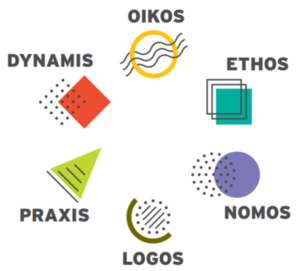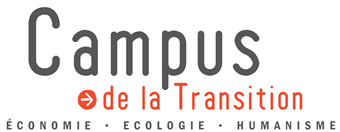An educational innovation: a course through 6 gateways
The handbook aims to give each and everyone analytic keys: understanding is needed for action, and training is needed for transformation. In a clear and accessible language, all readers have at their disposal contents and methods that can be used directly for their personal teaching or learning.
The questions at stake must be able to resonate for each student, regardless of his or her discipline and background, whether they study linguistics, plastic arts, management science or fluid mechanics, literature or law, sociology or nursing school.
Hence the idea of 6 gateways that can be explored in any order. Each gateway was given a Greek noun and a description beginning with a verb that best expresses the action:

- “Oikos” (which means house in Greek): to live in a common world.
- “Ethos” (behavior): to discern and decide for societal cohesion.
- “Logos” (speech): to interpret, criticize and imagine.
- “Nomos” (law): to measure, regulate and govern.
- “Praxis” (action): to act in accordance with the stakes.
- “Dynamis” (power): to reconnect with oneself, with others and with nature.
These 6 gateways lead to all the right questions to ask oneself in the face of the challenges of the “Great Transition”. Knowledge, interpersonal skills, and the ability to act complement and enrich each other in a global dynamic, integrating the “head-body-heart” pedagogy implemented at the Campus de la Transition since its creation. In other words, 6 gateways for action.
These are “tools” made available to everyone, adaptable to each context and each profile so that they can be used taking into account the problem to be addressed (such as Lego bricks). A programme, whatever it may be, having opened these six doors, will have addressed all the issues of the “Great Transition” in a holistic manner.
THE 6 GATEWAYS IN DETAIL
The six dimensions of teaching the “Great Transition”.
In order to “set oneself in motion” in the face of global warming and the degradation of our societies, the Great Transition Handbook establishes six “gateways” that can be taken in any direction in order to create one’s own path.
- “Oikos” sets the scene: the Earth, the common home. In this first entry, the diagnosis is placed on the side of hard science, identifying the risks of making our “planet uninhabitable” and our “unliveable world” and allowing us to think about how to preserve the resources that are being depleted.
- “Ethos” discusses the value system, defined by the philosopher Paul Ricœur as research aimed at “living well, with and for others, in just institutions”. This gateway discusses shared responsibilities – social, moral and political – to commit ourselves collectively towards the horizon of a desirable society.
- “Nomos” questions rules. Legal and economic disciplines are called upon here: are the current indicators relevant? Do they not give “absolute priority to growth, without concern for living equilibrium”? The calculation of gross domestic product (GDP), for example, does not take into account non-monetary and non-market activities. In the event of a natural disaster, the material means to address the crisis will make it increase disproportionately.
- “Logos” brings about language and reason, which invite us to question the stories of transition. To the expression “climate change”, should we prefer “climate emergency”? The English daily The Guardian works to avoid minimizing these questions by readers, who could be “put to sleep by a vocabulary that is too soft”. The objective is to be lucid, without obeying pure catastrophism.
- “Praxis“, practice calls for action. If a flapping of wings in Tokyo has repercussions in Brazil, how can we find convergent logics, and link the different scales of social and citizen mobilization? At a time when inequalities are increasing, can we continue to oppose “end of the world” and “end of the month”? Can we reconcile social movements and climate marches such as “yellow vests” and “fridays for future”?
- To complete the circle, “Dynamis“, power, proposes a reconnection to oneself and to nature, promoting a form of resilience. Can spiritual, cultural and religious traditions help us to get through the disasters that are predicted? The idea of “happy sobriety”, or “the power of restraint” with concrete proposals such as permaculture or the creation of local currencies, promotes both respect for the environment and social cohesion.
Between each gateway, reflection exercises serve as a break.
Source : Un nouveau « manuel de la grande transition » pour former tous les étudiants au défi climatique
Le Monde, November 16, 2020
